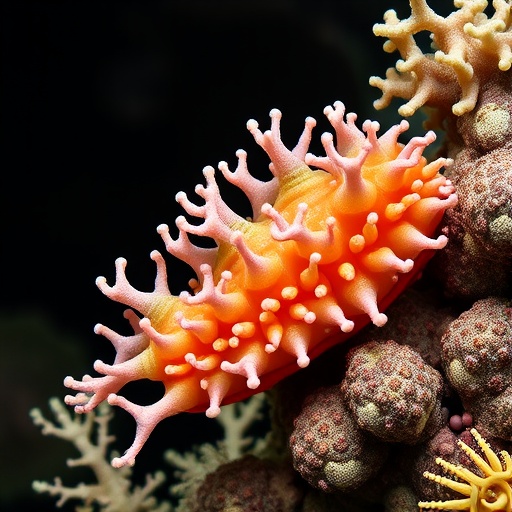In a groundbreaking study published in Coral Reefs, researchers have unveiled remarkable insights into the reproductive behaviors of coral species through a detailed examination of sex ratios and gamete production. Led by a team of scientists comprising Gantt, Grupstra, and Aichelman, this research aims to decipher the complexities surrounding cryptic coral lineages and their responses to varying thermal environments. Coral reefs, often termed the ‘rainforests of the sea,’ are not only beautiful but also essential ecosystems that support a multitude of marine life. Understanding their reproductive patterns is crucial for conservation efforts, especially in the face of climate change.
The study begins with a systematic approach to analyzing different coral species that display cryptic characteristics. These cryptic lineages, which are often indistinguishable in outward appearance, may possess distinct biological and ecological traits. This means that their reproductive strategies could vary significantly, making a one-size-fits-all conservation strategy ineffective. By identifying and examining these subtle differences, researchers hope to shed light on how various coral populations might adapt to or succumb under changing environmental conditions.
One of the striking findings of this study is the variation in sex ratios among different coral lineages. The investigators observed that some lineages exhibit skewed sex ratios, which could have profound implications for their reproductive success. In ecosystems where the balance of male and female corals is disrupted, the ability of these organisms to reproduce effectively could be severely compromised, ultimately threatening the survival of entire coral populations. This study underscores the necessity of considering sex ratios in ecological assessments and conservation strategies.
In addition to sex ratios, the research also delves into gamete production, the process through which corals generate and release eggs and sperm into the surrounding water. It was found that thermal environments—ranging from cooler to warmer waters—had significant effects on both the quantity and timing of gamete release. In warmer waters, some coral species increased their gamete production to ensure reproduction before potential thermal stress could occur. This adaptive strategy highlights the complexity of coral reproductive biology and the potential for resilience against climate change.
Furthermore, the research emphasizes the need for localized conservation strategies tailored to specific coral lineages. Since different lineages display unique responses to thermal stress, a uniform approach to coral reef management may not suffice. This finding advocates for more nuanced conservation efforts that take into account the biological diversity within coral populations. Such strategies could include targeted breeding programs and habitat restoration projects aimed at enhancing the resilience of vulnerable coral lineages.
Moreover, the implications of this study extend beyond academic interest. Coral reefs play a crucial role in coastal protection, tourism, and fisheries, contributing billions to the global economy. The decline of coral health due to climate change poses significant risks not just to marine biodiversity but also to human communities that rely on these ecosystems for their livelihoods. As such, enhancing our understanding of coral reproduction becomes an urgent priority in global conservation efforts.
The intricate relationship between gamete production and environmental conditions opens new avenues for future research. Understanding how different factors—such as ocean temperature, acidity, and nutrient availability—affect coral reproduction could provide valuable insights into climate resilience. Behavioral adaptations in breeding strategies may also reveal the potential for corals to withstand future environmental stressors.
Additionally, the research paves the way for further exploration into the genetic and molecular mechanisms that regulate reproductive success in corals. By identifying genes associated with sex determination and gamete development, scientists may uncover the foundational biological processes that underpin these phenomena. Such investigations could lead to innovative environmental management practices, aimed at boosting coral reproductive output in a warming world.
The study’s context also emphasizes the role of citizen science and community involvement in coral conservation. Engaging local populations in monitoring coral health and reproduction can enhance data collection, while also fostering a sense of stewardship and responsibility toward the marine environment. Community-driven initiatives can act as a catalyst for more comprehensive conservation schemes, ensuring that local knowledge and participation are at the forefront of ecological efforts.
To sum up, the research led by Gantt, Grupstra, and Aichelman signifies a pivotal advancement in our understanding of coral reproductive biology. As the climate crisis intensifies, insights derived from this study could inform effective strategies for coral conservation, safeguard marine biodiversity, and ensure the longevity of coral reefs for future generations. The need for integrated research that encompasses ecological, genetic, and community perspectives will be indispensable as we strive to protect these vital ecosystems from imminent threats.
In conclusion, the ongoing research into sex ratios and gamete production across cryptic coral lineages is illuminating the nuanced world of coral biology. It challenges traditional conceptions of coral populations and opens doors for more effective conservation practices tailored to the specific needs of diverse coral species. Such efforts are no longer just an academic exercise; they are essential for the survival of the world’s coral reefs amid a rapidly changing planet. As we look to the future, it is clear that the preservation of these glittering underwater worlds hinges not only on scientific discovery but also on our collective responsibility to protect and restore them.
Subject of Research: Coral reproductive biology, specifically sex ratios and gamete production across cryptic lineages in varying thermal environments.
Article Title: Sex ratios and gamete production vary across cryptic coral lineages and thermal environments.
Article References:
Gantt, S.E., Grupstra, C.G.B., Aichelman, H.E. et al. Sex ratios and gamete production vary across cryptic coral lineages and thermal environments.
Coral Reefs (2025). https://doi.org/10.1007/s00338-025-02786-8
Image Credits: AI Generated
DOI: https://doi.org/10.1007/s00338-025-02786-8
Keywords: Coral reefs, sex ratios, gamete production, climate change, conservation strategies, reproductive biology.




